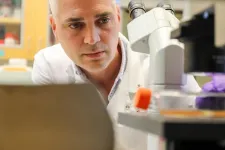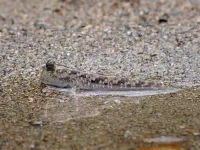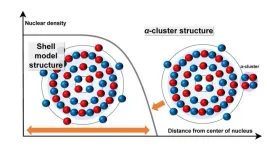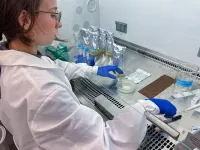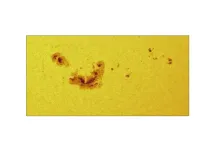(Press-News.org) New research led by Oregon Health & Science University reveals a promising approach to developing a universal influenza vaccine — a so-called “one and done” vaccine that confers lifetime immunity against an evolving virus.
The study, published today in the journal Nature Communications, tested an OHSU-developed vaccine platform against the virus considered most likely to trigger the next pandemic.
Researchers reported the vaccine generated a robust immune response in nonhuman primates that were exposed to the avian H5N1 influenza virus. But the vaccine wasn’t based on the contemporary H5N1 virus; instead, the primates were inoculated against the influenza virus of 1918 that killed millions of people worldwide.
“It’s exciting because in most cases, this kind of basic science research advances the science very gradually; in 20 years, it might become something,” said senior author Jonah Sacha, Ph.D., professor and chief of the Division of Pathobiology at OHSU’s Oregon National Primate Research Center. “This could actually become a vaccine in five years or less.”
Researchers reported that six of 11 nonhuman primates inoculated against the virus that circulated a century ago — the 1918 flu — survived exposure to one of the deadliest viruses in the world today, H5N1. In contrast, a control group of six unvaccinated primates exposed to the H5N1 virus succumbed to the disease.
Sacha said he believes the platform “absolutely” could be useful against other mutating viruses, including SARS-CoV-2.
“It’s a very viable approach,” he said. “For viruses of pandemic potential, it’s critical to have something like this. We set out to test influenza, but we don’t know what’s going to come next.”
A senior co-author from the University of Pittsburgh concurred.
“Should a deadly virus such as H5N1 infect a human and ignite a pandemic, we need to quickly validate and deploy a new vaccine,” said co-corresponding author Douglas Reed, Ph.D., associate professor of immunology at the University of Pittsburgh Center for Vaccine Research.
Finding a stationary target
This approach harnesses a vaccine platform previously developed by scientists at OHSU to fight HIV and tuberculosis, and in fact is already being used in a clinical trial against HIV.
The method involves inserting small pieces of target pathogens into the common herpes virus cytomegalovirus, or CMV, which infects most people in their lifetimes and typically produces mild or no symptoms. The virus acts as a vector specifically designed to induce an immune response from the body’s own T cells.
This approach differs from common vaccines — including the existing flu vaccines — which are designed to induce an antibody response that targets the most recent evolution of the virus, distinguished by the arrangement of proteins covering the exterior surface.
“The problem with influenza is that it’s not just one virus,” Sacha said. “Like the SARS-CoV-2 virus, it’s always evolving the next variant and we’re always left to chase where the virus was, not where it’s going to be.”
The spike proteins on the virus exterior surface evolve to elude antibodies. In the case of flu, vaccines are updated regularly using a best estimate of the next evolution of the virus. Sometimes it’s accurate, sometimes less so.
In contrast, a specific type of T cell in the lungs, known as effector memory T cell, targets the internal structural proteins of the virus, rather than its continually mutating outer envelope. This internal structure doesn’t change much over time — presenting a stationary target for T cells to search out and destroy any cells infected by an old or newly evolved influenza virus.
Success with a century-old template
To test their T cell theory, researchers designed a CMV-based vaccine using the 1918 influenza virus as a template. Working within a highly secure biosafety level 3 laboratory at the University of Pittsburgh, they exposed the vaccinated nonhuman primates to small particle aerosols containing the avian H5N1 influenza virus — an especially severe virus that is currently circulating among dairy cows in the United States.
Remarkably, six of the 11 vaccinated primates survived the exposure, despite the century-long period of virus evolution.
“It worked because the interior protein of the virus was so well preserved,” Sacha said. “So much so, that even after almost 100 years of evolution, the virus can’t change those critically important parts of itself.”
The study raises the potential for developing a protective vaccine against H5N1 in people.
“Inhalation of aerosolized H5N1 influenza virus causes a cascade of events that can trigger respiratory failure,” said co-senior author Simon Barratt-Boyes, Ph.D., professor of infectious diseases, microbiology and immunology at Pitt. “The immunity induced by the vaccine was sufficient to limit virus infection and lung damage, protecting the monkeys from this very serious infection.”
By synthesizing more up-to-date virus templates, the new study suggests CMV vaccines may be able to generate an effective, long-lasting immune response against a wide suite of new variants.
“I think it means within five to 10 years, a one-and-done shot for influenza is realistic,” Sacha said.
The same CMV platform developed by OHSU researchers has advanced to a clinical trial to protect against HIV, and a recent publication by those scientists suggests it may even be useful targeting specific cancer cells. The HIV clinical trial is being led by Vir Biotechnology, which licensed the vaccine platform from OHSU.
Sacha sees the development as the latest in the rapid advance of medical research to treat or prevent disease.
“It’s a massive sea change within our lifetimes,” Sacha said. “There is no question we are on the cusp of the next generation of how we address infectious disease.”
In addition to OHSU, research institutions involved in the study included the Tulane National Primate Research Center, the University of Pittsburgh, the University of Washington, and the Washington National Primate Research Center at the UW.
In the interest of ensuring the integrity of our research and as part of our commitment to public transparency, OHSU actively regulates, tracks and manages relationships that our researchers may hold with entities outside of OHSU. In regard to this research, OHSU and OHSU faculty involved in this research, including Jonah Sacha, Ph.D., have a significant financial interest in VIR Biotechnology Inc., a company that may have a commercial interest in the results of this research and technology.
All research involving animal subjects is reviewed and approved by a university’s Institutional Animal Care and Use Committee (IACUC). The IACUC’s priority is to ensure the health and safety of animal research subjects. The IACUC also reviews procedures to ensure the health and safety of the people who work with the animals. The IACUC conducts a rigorous review of all animal research proposals to ensure they demonstrate scientific value and justify the use of live animals.
The research was supported by the Bill & Melinda Gates Foundation Grand Challenges grant awards OPP1213553 and National Institute of Allergy And Infectious Diseases of the National Institutes of Health award R01AI40888; with support from the Office of the Director of the National Institutes of Health award P51OD011092 to the Oregon National Primate Research Center at OHSU. The findings and conclusions contained within are those of the authors and do not necessarily reflect positions or policies of the Bill & Melinda Gates Foundation or the National Institutes of Health.
END
Study shows promise for a universal influenza vaccine
OHSU-led research uses innovative vaccine platform to target interior of virus; scientists validate theory using 1918 flu virus
2024-07-19
ELSE PRESS RELEASES FROM THIS DATE:
To walk, you only need fins (and maybe a sense of adventure)
2024-07-19
Okinawa’s mangrove forests are home to many animal species, from crabs to kingfishers; they host a diverse ecosystem teeming with life. Among the quirkier residents living there is “Minami-Tobihaze” — the barred mudskipper. “They are fish, but they can walk and live partly on land,” says Dr. Fabienne Ziadi-Künzli from the Nonlinear and Non-equilibrium Physics Unit, who is the first author of a study on mudskipper anatomy, which was recently published in the Journal of Anatomy.
Adapting to a new life
The barred mudskipper, scientifically called Periophthalmus argentilineatus, has more than just one oddity. Their eyes ...
Come closer: titanium-48’s nuclear structure changes when observed at varying distances
2024-07-19
The world around us is made up of particles invisible to the naked eye, but physicists continue to gain insights into this mysterious realm. Findings published in Physical Review C by Osaka Metropolitan University researchers show that the nuclear structure of an atom likely changes depending on the distance the protons and neutrons are from the center of the nucleus.
OMU graduate student Maito Okada, Associate Professor Wataru Horiuchi, and Professor Naoyuki Itagaki from the Graduate School of Science compared calculations using theoretical models with existing experimental data to determine whether titanium-48, the most common isotope of titanium with 22 protons and 26 neutrons, ...
Good timing: UNLV study unravels how our brains track time
2024-07-19
Ever hear the old adage that time flies when you’re having fun? A new study by a team of UNLV researchers suggests that there’s a lot of truth to the trope.
Many people think of their brains as being intrinsically synced to the man-made clocks on their electronic devices, counting time in very specific, minute-by-minute increments. But the study, published this month in the latest issue of the peer-reviewed Cell Press journal Current Biology, showed that our brains don’t work that way.
By analyzing changes in brain activity patterns, the research team ...
Positive and negative impacts of interfacial hydrogen bonds on photocatalytic hydrogen evolution
2024-07-19
Photocatalytic hydrogen evolution from water is a key technology for achieving sustainable hydrogen production. However, the direct impact of the microscopic structure of interfacial water molecules on photocatalytic reactivity remains unexplored. In this study, the crucial roles of interfacial hydrogen bond structure and dynamics, as well as the optimal interfacial water environment for promoting H2 evolution were uncovered. These findings provide molecular-level insights that can guide the design of interfacial water conditions to enhance photocatalytic performance.
Hydrogen production via photocatalytic water splitting is a sustainable ...
SynGAP Research Fund (SRF) continues support for exosome research for SYNGAP1-Related Disorders (SRD) in the lab of Professor Janos Zempleni of the University of Nebraska-Lincoln
2024-07-19
Mill Valley, CA – July 10, 2024 – The SynGAP Research Fund 501(c)(3) announces a $190,636 grant, for work to be done in 2024 and 2025, to Professor Janos Zempleni, PhD of the University of Nebraska-Lincoln, to establish data required for regulatory approval for his novel treatment using an engineered version of naturally-occurring particles called exosomes. His first grant from SRF established the engineered changes required to accumulate exosomes in the brain. SRF is pleased to support the continued development of a non-invasive and targeted delivery system for therapeutics ...
Food research fellowships funded for scientists in 6 countries
2024-07-19
DALLAS, July 18, 2024 — Diet-related diseases account for 1 in 5 deaths around the world[1] and unsustainable industrial agricultural practices threaten to compromise the health of the planet.[2] While emerging science expands our knowledge of food composition, society still understands little about the tens of thousands of components found in food.
The American Heart Association is facilitating a new research fellowship program from the Periodic Table of Food Initiative (PTFI) with support from The Rockefeller Foundation. The program, called Good Food Fellows, aims to train a new ...
Illinois studies explore converting wastewater to fertilizer with fungal treatment
2024-07-19
URBANA, Ill. – Creating fertilizers from organic waste can help reduce the consumption of fossil fuels and promote sustainable production. One way of doing this is through hydrothermal liquefaction (HTL), which converts biomass into biocrude oil through a high-temperature, high-pressure process. Two studies from the University of Illinois Urbana-Champaign explore the use of a fungal treatment to convert the leftover wastewater into fertilizer for agricultural crops.
“HTL uses wet biomass from organic sources such as swine manure or food waste. The process yields wastewater, called hydrothermal liquefaction aqueous phase (HTL-AP), which is usually discarded. We ...
Time-lapse imaging for embryo selection in IVF does not improve the odds of live birth compared with conventional methods, according to largest study of its kind
2024-07-19
There is no difference in live birth rates between time-lapse imaging and other standard approaches used in in-vitro fertilisation (IVF) for embryo incubation and selection prior to implantation, according to the results of the largest trial of its kind.
The randomised controlled trial looked at IVF outcomes in the UK and Hong Kong. The results, published today in The Lancet, provide much-needed evidence that using time-lapse imaging (TLI) does not improve treatment outcomes for someone undergoing fertility treatment.
Time-lapse imaging is a technique ...
Early riser! The Sun is already starting its next solar cycle – despite being halfway through its current one
2024-07-19
Early riser! The Sun is already starting its next solar cycle – despite being halfway through its current one
Royal Astronomical Society press release
RAS PR 24/21 (NAM 7)
Embargoed until 00:01 BST on Friday 19 July 2024
The first rumblings of the Sun's next 11-year solar cycle have been detected in sound waves inside our home star – even though it is only halfway through its current one.
This existing cycle is now at its peak, or 'solar maximum' - which is when the Sun’s magnetic field flips and its poles swap places - until mid-2025.
It affects ...
Oakland hospital building is approved for construction
2024-07-19
Subscribe to UCSF News
Note to Editors: Photos and renderings are available in our Media Kit
UC Regents sign off on $1.5 billion project to construct a new hospital building at UCSF Benioff Children’s Hospital Oakland, securing the future of world-class pediatric facilities in the East Bay.
UCSF Benioff Children’s Hospitals has received final approval on a $1.49 billion hospital building on its Oakland campus that will provide a state-of-the-art, child-centered medical facility for families across the Bay Area. The proposal was approved ...
LAST 30 PRESS RELEASES:
New software sheds light on cancer’s hidden genetic networks
UT Health San Antonio awarded $3 million in CPRIT grants to bolster cancer research and prevention efforts in South Texas
Third symposium spotlights global challenge of new contaminants in China’s fight against pollution
From straw to soil harmony: International team reveals how biochar supercharges carbon-smart farming
Myeloma: How AI is redrawing the map of cancer care
Manhattan E. Charurat, Ph.D., MHS invested as the Homer and Martha Gudelsky Distinguished Professor in Medicine at the University of Maryland School of Medicine
Insilico Medicine’s Pharma.AI Q4 Winter Launch Recap: Revolutionizing drug discovery with cutting-edge AI innovations, accelerating the path to pharmaceutical superintelligence
Nanoplastics have diet-dependent impacts on digestive system health
Brain neuron death occurs throughout life and increases with age, a natural human protein drug may halt neuron death in Alzheimer’s disease
SPIE and CLP announce the recipients of the 2025 Advanced Photonics Young Innovator Award
Lessons from the Caldor Fire’s Christmas Valley ‘Miracle’
Ant societies rose by trading individual protection for collective power
Research reveals how ancient viral DNA shapes early embryonic development
A molecular gatekeeper that controls protein synthesis
New ‘cloaking device’ concept to shield sensitive tech from magnetic fields
Researchers show impact of mountain building and climate change on alpine biodiversity
Study models the transition from Neanderthals to modern humans in Europe
University of Phoenix College of Doctoral Studies releases white paper on AI-driven skilling to reduce burnout and restore worker autonomy
AIs fail at the game of visual “telephone”
The levers for a sustainable food system
Potential changes in US homelessness by ending federal support for housing first programs
Vulnerability of large language models to prompt injection when providing medical advice
Researchers develop new system for high-energy-density, long-life, multi-electron transfer bromine-based flow batteries
Ending federal support for housing first programs could increase U.S. homelessness by 5% in one year, new JAMA study finds
New research uncovers molecular ‘safety switch’ shielding cancers from immune attack
Bacteria resisting viral infection can still sink carbon to ocean floor
Younger biological age may increase depression risk in older women during COVID-19
Bharat Innovates 2026 National Basecamp Showcases India’s Most Promising Deep-Tech Ventures
Here’s what determines whether your income level rises or falls
SCIE indexation achievement: Celebrate with Space: Science & Technology
[Press-News.org] Study shows promise for a universal influenza vaccineOHSU-led research uses innovative vaccine platform to target interior of virus; scientists validate theory using 1918 flu virus
